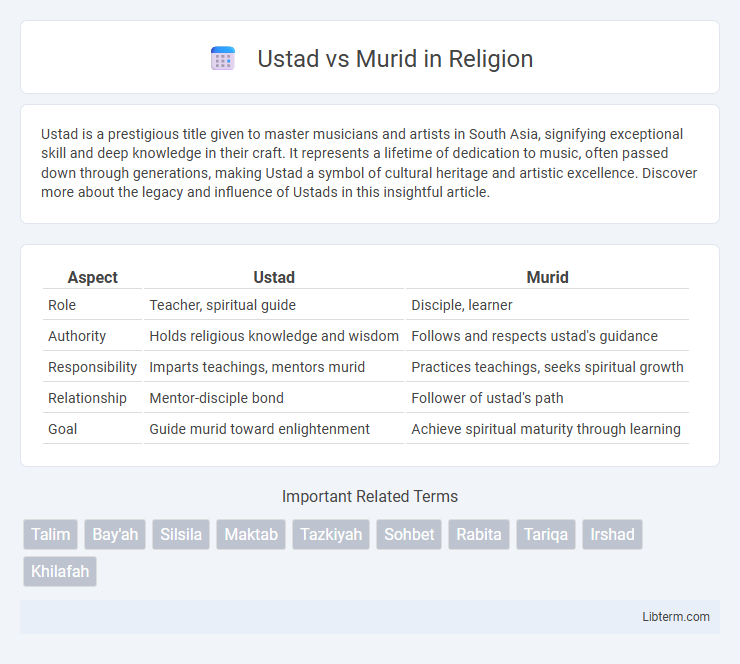Ustad is a prestigious title given to master musicians and artists in South Asia, signifying exceptional skill and deep knowledge in their craft. It represents a lifetime of dedication to music, often passed down through generations, making Ustad a symbol of cultural heritage and artistic excellence. Discover more about the legacy and influence of Ustads in this insightful article.
Table of Comparison
| Aspect | Ustad | Murid |
|---|---|---|
| Role | Teacher, spiritual guide | Disciple, learner |
| Authority | Holds religious knowledge and wisdom | Follows and respects ustad's guidance |
| Responsibility | Imparts teachings, mentors murid | Practices teachings, seeks spiritual growth |
| Relationship | Mentor-disciple bond | Follower of ustad's path |
| Goal | Guide murid toward enlightenment | Achieve spiritual maturity through learning |
Understanding the Ustad-Murid Relationship
The Ustad-Murid relationship is a traditional teacher-student dynamic rooted in trust, respect, and knowledge transmission, primarily observed in South Asian music and spiritual practices. The Ustad, as the master, imparts nuanced skills and wisdom, while the Murid, the disciple, dedicates themselves to disciplined learning and replication of the teachings. This bond fosters not only technical mastery but also spiritual growth, encapsulating a holistic educational experience beyond conventional instruction.
Historical Origins of Ustad and Murid
The terms "Ustad" and "Murid" trace back to the rich traditions of Sufism and classical South Asian arts, where the Ustad denotes a master or teacher with profound expertise, and the Murid signifies a disciple or student committed to spiritual and practical learning. Historically, the Ustad-Murid relationship emerged during medieval Islamic cultures, particularly within the Indian subcontinent, fostering a pedagogical model centered on oral transmission and mentorship in fields like music, poetry, and Sufi mysticism. This ancient master-disciple dynamic played a crucial role in preserving and advancing artistic and spiritual knowledge across generations.
Roles and Responsibilities of an Ustad
An Ustad serves as a master teacher responsible for imparting deep knowledge, technical skills, and cultural values to their Murid (student) in traditional arts such as music or craftsmanship. They design tailored lessons, provide constructive feedback, and uphold the integrity of the discipline by preserving its techniques and traditions. The Ustad also mentors the Murid in developing discipline, creativity, and a spiritual connection to the art form, ensuring holistic growth.
Qualities of a Dedicated Murid
A dedicated murid exhibits unwavering commitment, humility, and patience, essential for absorbing the spiritual guidance provided by the ustad. They actively practice self-discipline, sincerely follow teachings, and maintain respect and trust in the ustad's wisdom. This deep devotion fosters transformative spiritual growth and strengthens the murid-ustad relationship.
The Importance of Trust in Ustad-Murid Dynamics
Trust forms the foundation of the Ustad-Murid relationship, enabling effective transmission of knowledge and skills in traditional arts and crafts. The Ustad relies on the Murid's commitment and sincerity, while the Murid depends on the Ustad's expertise and guidance for growth and mastery. This mutual trust ensures a deep, transformative learning experience that transcends mere instruction.
Methods of Knowledge Transmission
Ustad and Murid engage in a traditional knowledge transmission process rooted in oral teaching and experiential learning, where the Ustad imparts wisdom through personalized guidance and demonstration. This method emphasizes direct interaction, memorization, and imitation, ensuring the Murid absorbs both theoretical concepts and practical skills. The dynamic fosters a deep mentor-student bond, crucial for preserving cultural, artistic, or spiritual practices across generations.
The Spiritual Bond Between Ustad and Murid
The spiritual bond between Ustad and Murid transcends a traditional teacher-student relationship, rooted deeply in mutual trust and devotion within Sufi traditions. The Ustad imparts not only knowledge but also spiritual guidance, nurturing the Murid's inner transformation through personalized mentorship and shared mystical experiences. This connection fosters profound growth, as the Murid absorbs the Ustad's wisdom and embodies the path toward divine realization.
Modern Challenges in the Ustad-Murid System
Modern challenges in the Ustad-Murid system include digital distractions that disrupt traditional one-on-one learning dynamics and the diminishing availability of authentic Ustads due to urban migration and changing socio-economic conditions. The rise of online platforms and mass education often dilutes personalized mentorship, making it difficult to preserve the depth of knowledge transmission inherent in this system. Furthermore, cultural shifts and commercialization of art forms threaten the integrity and continuity of the Ustad-Murid relationship, impacting skill mastery and spiritual growth.
The Transformative Impact of the Ustad-Murid Connection
The Ustad-Murid connection fosters profound personal and artistic growth by enabling the Murid to absorb not only technical skills but also the spiritual and cultural essence imparted by the Ustad. This dynamic mentorship creates a transformative learning environment where traditional knowledge is transmitted through immersive interaction, reinforcing discipline, creativity, and emotional depth. The enduring legacy of this relationship shapes generations of practitioners, preserving cultural heritage while encouraging innovative expression within classical arts.
Preserving the Tradition in Contemporary Society
Ustad and Murid relationships play a crucial role in preserving traditional art forms and cultural heritage in contemporary society by fostering direct mentorship that transmits skills, values, and historical knowledge. This dynamic ensures authenticity and continuity as the Ustad imparts not only technical expertise but also the philosophical and ethical foundations crucial to the tradition. Such personalized guidance helps navigate modern challenges, maintaining relevance while safeguarding the integrity of classical practices.
Ustad Infographic

 libterm.com
libterm.com